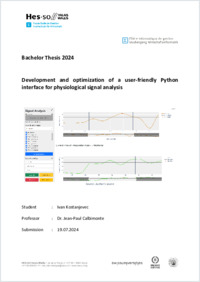Development and optimization of a user-friendly Python interface for physiological signal analysis
SONAR|HES-SO
- Kostanjevec, Ivan
- Calbimonte, Jean-Paul (Degree supervisor)
- Sierre : Haute Ecole de Gestion Valais, 2024
94 pages
Bachelor of Science HES-SO (BSc) in Business Information Technology: Haute Ecole de Gestion Valais, 2024
English
Researchers at the Centre de Médicine Intégrative et Complémentaire (CEMIC) are studying the effects of complementary approaches such as hypnosis in patients that suffer from chronic pain. The clinical efficacy of hypnosis is well established, but the underlying mechanisms are not identified yet. One hypothesis is an effect on the autonomic nervous system (ANS). They record physiological signals, reflecting the ANS activity during clinical sessions of medical hypnosis. To analyze these signals, they have an old tool which has some major limitations: The tool can only analyze ECG signals and it takes very long to process the data.
During this project, the old tool was improved in three ways: Firstly, the tool was optimized, in order to improve the loading times of the ECG analysis. With the new application the loading times improved by up to 39 times. Secondly, the tool was extended, so that more signals could be analyzed, this includes ECG, BVP, EDA, and RSP signals. And finally, the tool was made more user-friendly, by following Nielsen’s ten usability heuristics. Both, the old and new tool are written in Python and use the same packages: Dash for the UI and NeuroKit2 for necessary calculations that need to be performed on the signal data.
At the end of the project, the tool was tested by two selected researchers from CEMIC. They pointed out some possible improvements but liked the tool in general. All mentioned improvements could be implemented in the new tool before the end of the project.
During this project, the old tool was improved in three ways: Firstly, the tool was optimized, in order to improve the loading times of the ECG analysis. With the new application the loading times improved by up to 39 times. Secondly, the tool was extended, so that more signals could be analyzed, this includes ECG, BVP, EDA, and RSP signals. And finally, the tool was made more user-friendly, by following Nielsen’s ten usability heuristics. Both, the old and new tool are written in Python and use the same packages: Dash for the UI and NeuroKit2 for necessary calculations that need to be performed on the signal data.
At the end of the project, the tool was tested by two selected researchers from CEMIC. They pointed out some possible improvements but liked the tool in general. All mentioned improvements could be implemented in the new tool before the end of the project.
- Language
-
- English
- Classification
- Computer science and technology
- Notes
-
- Haute Ecole de Gestion Valais
- Informatique de gestion - Wirtschaftsinformatik
- hesso:hegvs
- Persistent URL
- https://sonar.ch/global/documents/329885
Statistics
Document views: 154
File downloads:
- Kostanjevec_Ivan_2024.pdf: 149
